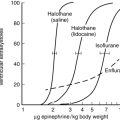Blood gas temperature correction
When the sample is analyzed, it is heated to 37° C, which causes a decrease in the solubility and falsely elevates partial-pressure values. Conversely, if the temperature of the blood decreases, the solubility of O2 and CO2 increases, which consequently lowers the partial pressures of these gases (i.e., decreases PO2 and PCO2). PCO2 decreases by approximately 4.5% for each 1° C temperature decrease (Table 24-1). Therefore, temperature correction—the process of correcting the machine values to the patient values in vivo at the patient’s actual temperature—is needed to determine the patient’s actual partial pressures of PO2 and PCO2. Changes in temperature also affect pH. As temperature decreases, less water is dissociated into OH– and H+, and, thus, pH will rise, as will the pOH. The pH rises approximately 0.015 unit for each 1° C decrease in temperature. If the patient’s temperature is less than 37° C, but the blood sample is subsequently heated to 37° C in the analyzer, then elevated levels of H+ (and OH−) will be recorded, leading to a falsely decreased pH value compared with the patient’s actual pH.
Table 24-1
Effects of Hypothermia on PCO2, PO2, and pH
| Parameter | Effect of Hypothermia | Effect/Change in Temperature |
| PCO2 | ↓ | 4.5%/° C |
| PO2 | ↓ | 4.5%/° C |
| pH | ↑ | 0.015 unit/° C |
Comparison of the two systems
Patients managed by the pH-stat approach would be considered hypercarbic and have a lower pH (i.e., a respiratory acidosis) by the α-stat approach, and α-stat management would be considered a relative respiratory alkalosis by the pH-stat system (Table 24-2). The blood of cold-blooded animals (ectotherms) undergoes pH changes during cooling, parallel to the changes that water undergoes (α-stat). On the other hand, homeothermic mammals, in effect, have “corrected” blood gases during hibernation, and their decreased metabolic function produces anesthetic effects.
Table 24-2
Effects of Temperature Correction
| Parameter | pH-Stat as Viewed by α-Stat | α-Stat as Viewed by pH-Stat |
| CO2 | ↑ | ↓ |
| pH | ↓ | ↑ |
| Condition | Respiratory acidosis | Respiratory alkalosis |





